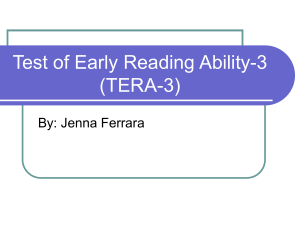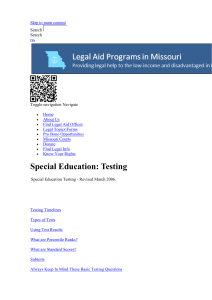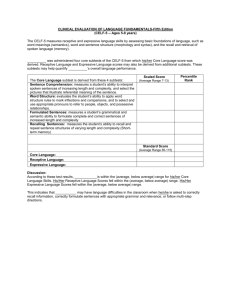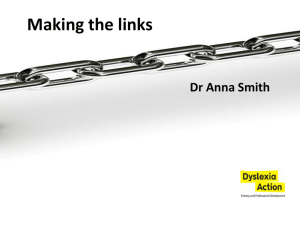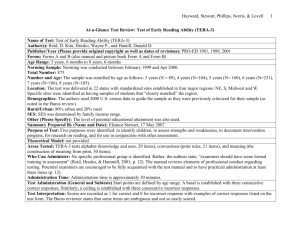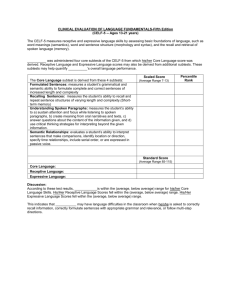AAG-Test of Word Rea..
advertisement
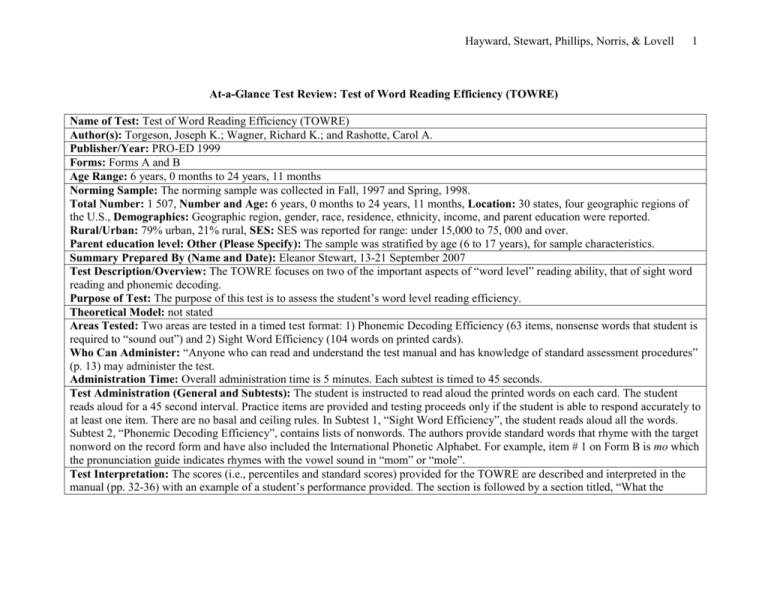
Hayward, Stewart, Phillips, Norris, & Lovell 1 At-a-Glance Test Review: Test of Word Reading Efficiency (TOWRE) Name of Test: Test of Word Reading Efficiency (TOWRE) Author(s): Torgeson, Joseph K.; Wagner, Richard K.; and Rashotte, Carol A. Publisher/Year: PRO-ED 1999 Forms: Forms A and B Age Range: 6 years, 0 months to 24 years, 11 months Norming Sample: The norming sample was collected in Fall, 1997 and Spring, 1998. Total Number: 1 507, Number and Age: 6 years, 0 months to 24 years, 11 months, Location: 30 states, four geographic regions of the U.S., Demographics: Geographic region, gender, race, residence, ethnicity, income, and parent education were reported. Rural/Urban: 79% urban, 21% rural, SES: SES was reported for range: under 15,000 to 75, 000 and over. Parent education level: Other (Please Specify): The sample was stratified by age (6 to 17 years), for sample characteristics. Summary Prepared By (Name and Date): Eleanor Stewart, 13-21 September 2007 Test Description/Overview: The TOWRE focuses on two of the important aspects of “word level” reading ability, that of sight word reading and phonemic decoding. Purpose of Test: The purpose of this test is to assess the student’s word level reading efficiency. Theoretical Model: not stated Areas Tested: Two areas are tested in a timed test format: 1) Phonemic Decoding Efficiency (63 items, nonsense words that student is required to “sound out”) and 2) Sight Word Efficiency (104 words on printed cards). Who Can Administer: “Anyone who can read and understand the test manual and has knowledge of standard assessment procedures” (p. 13) may administer the test. Administration Time: Overall administration time is 5 minutes. Each subtest is timed to 45 seconds. Test Administration (General and Subtests): The student is instructed to read aloud the printed words on each card. The student reads aloud for a 45 second interval. Practice items are provided and testing proceeds only if the student is able to respond accurately to at least one item. There are no basal and ceiling rules. In Subtest 1, “Sight Word Efficiency”, the student reads aloud all the words. Subtest 2, “Phonemic Decoding Efficiency”, contains lists of nonwords. The authors provide standard words that rhyme with the target nonword on the record form and have also included the International Phonetic Alphabet. For example, item # 1 on Form B is mo which the pronunciation guide indicates rhymes with the vowel sound in “mom” or “mole”. Test Interpretation: The scores (i.e., percentiles and standard scores) provided for the TOWRE are described and interpreted in the manual (pp. 32-36) with an example of a student’s performance provided. The section is followed by a section titled, “What the Hayward, Stewart, Phillips, Norris, & Lovell 2 TOWRE Scores Mean”. Supporting research is referenced. The next section focuses on “Instructional Implications for Low Scores on Each Subtest”. The authors provide information on general trends in reading instruction with the caveat that much remains to be discovered about what poor performance indicates, when to intervene, and what to do in intervention. The authors’ interpretation of younger children’s performance, they note that “the test may measure slightly different skills at different periods in reading growth” (Torgeson, Wagner, & Rashotte, 1999, p. 42). Discrepancy analysis is done in order to decide whether the difference in scores constitutes an important, rather than mere chance, difference. Minimal differences between TOWRE scores indicating clinical significance are presented in Table 4.4 (p. 45). A student’s progress can be monitored over a school year by the administration of alternate forms. Standardization: Age equivalent scores Grade equivalent scores Percentiles Standard scores Stanines Other (Please Specify) A total standard score is calculated from the two subtest standard scores Reliability: Internal consistency of items: Alternate-form reliability was used. The subtests and the total scores all exceeded the .80 level. SEMs provided ranged between three and six with averages of four for subtests and three for the Total Word Reading Efficiency. Test-retest: 72 participants in three age ranges from Tallahassee, Florida were retested after a two-week interval. The values of r ranged from a low of .82 to a high of .97. Inter-rater: Two PRO-ED staff members independently scored 30 randomly selected completed tests. Coefficients were .99 across the subtests and the total test. Other (Please Specify): When testing for equivalence of forms, coefficients were .86 or better, with most above .90. Validity: Content: These authors cite key research to support their rationale for choosing these skills as targets. The Reading Teacher’s Book of Lists (Fry, Kress, & Fountoukidis, 1993) was the primary source consulted for word selection. Words were arranged in the test lists from high frequency to less frequent occurrence. Conventional Item Analysis: Item difficulty and item discrimination are reported. Discrimination indexes of .35 or higher with values for median discriminating powers ranging from .40 to .75. Median Item Difficulties: The item difficulty of the TOWRE meets the requirement. Differential Item Analysis: Using a logistic regression procedure with alpha set at .001, DIF analyses demonstrate that bias in these subtests appears to have been kept to a minimum. Criterion Prediction Validity: Concurrent Validitity: TOWRE was compared with WRMT-R at three grade levels. Correlations ranged from .89 to .94. In another study, 201 randomly selected elementary aged children were followed longitudinally, and correlations between TOWRE and WRMT-R subtests ranged from .86 to .89 at Grades 4 and 5. Predictive Validity: Children in grades 4 and 5 were tested and coefficients ranged from .47 (GORT-3 Rate and TOWRE Phonemic Decoding Efficiency) to .87 (WRMT-R Comprehension and TOWRE Sight Word Efficiency). In another longitudinal study, 201 randomly selected fifth grade children participated, and authors examined the relationships among the same subtests. Stronger relationships are demonstrated between whole Hayward, Stewart, Phillips, Norris, & Lovell 3 word readings skills and text reading and comprehension than decoding skills. Construct Identification Validity: Age differentiation: The means and standard deviations across all 13 age groups show a high correlation of age with performance (0.77 to 0.81). Group differentiation: Data are provided for the following groups: males and females, ethnic groups (European, African, Hispanic, and Asian Americans), and two categories of students with disabilities (speech language and learning disability). Examining mean standard scores on subtests across these groups indicated that gender and ethnic groups all performed within the normal range. Data suggest minimal test bias for gender and ethnic groups. Students with speechlanguage difficulties performed better than students with learning disabilities. Subtest Interrelationships: Coefficients range from 0.77 to 0.96. Factor analysis: Confirmatory factor analysis demonstrates that the two subtests were related but addressed different aspects of word reading efficiency. Item Validity: All discrimination coefficients reported in Table 7.1 are above .35. Word Reading Efficiency of Students with Severe Reading Disabilities: Children identified with severe word level reading difficulties who were given 67 hours of individual instruction in an eight-week block were tested. The results were presented in terms of gains in standard scores across several standardized measures of word reading skills (WRMT-R, GORT-3 and TOWRE). Performance on the TOWRE subtests accurately reflected the small improvements that occurred in reading fluency, and was much less affected by the relatively large increases in accuracy as reflected by both the word reading accuracy score on the GORT-3 and performance on the untimed measure of word reading (Torgeson , et al., 1999, p. 83). Differential Item Functioning: not stated, Other: Summary/Conclusions/Observations: The TOWRE presents comprehensive psychometric information. It appears to be a welldeveloped and constructed test that clinicians can use with confidence. However, I have included some comments from the Buros reviewers. “The content sampling plan for both subtests could be more descriptive and the predictive validity of the measure emphasized more” Tindal & Vacca, 2003, p. 963). “…It is unclear how the words selected on the TOWRE (both real and nonsense) related to the ample information presented in the authors’ discussion of the test’s rationale. Further, is it equally unclear how the 45second time frame was decided.” “In terms of psychometrics, there are concerns-the demographics of the norming sample, lack of specific information about item selection and the focus on timed exercises, lack of extensive data for reliability and validity, and the lack of specific guidance given as to how to interpret the standard scores received from the TOWRE” (Tindal & Vacca, 2003, pp. 963964). Clinical/Diagnostic Usefulness: This test is user-friendly and easy to administer with a minimum of materials needed. Hayward, Stewart, Phillips, Norris, & Lovell 4 References Fry, E. B., Kress, J. E., & Fountoukidis, D. L. (1993). The reading teacher’s book of lists. Englewood Cliffs, NJ: Prentice-Hall. Tindal, G., & Vacca, J. (2003). Test review of the Test of Word Reading Efficiency. In B.S. Plake, J.C. Impara, and R.A. Spies (Eds.), The fifteenth mental measurements yearbook (pp. 960-965). Lincoln, NE: Buros Institute of Mental Measurements. Torgeson, J. K., Wagner, R. K., & Rashotte, C. A. (1999). Test of word reading efficiency. Austin, TX: Pro-Ed. To cite this document: Hayward, D. V., Stewart, G. E., Phillips, L. M., Norris, S. P., & Lovell, M. A. (2008). At-a-glance test review: Test of word reading efficiency (TOWRE). Language, Phonological Awareness, and Reading Test Directory (pp. 1-4). Edmonton, AB: Canadian Centre for Research on Literacy. Retrieved [insert date] from http://www.uofaweb.ualberta.ca/elementaryed/ccrl.cfm.

